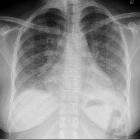immune reconstitution inflammatory syndrome
Immune reconstitution inflammatory syndrome (IRIS) is paradoxical deterioration of a pre-existing illness following abrupt improvement in an individual's immune function. It is classically seen in HIV/AIDS patients following initiation of highly active antiretroviral therapy (HAART). Increasingly, however, it is also seen in the setting of other diseases treated with immunomodulation (e.g. natalizumab-associated progressive multifocal leukoencephalopathy immune reconstitution inflammatory syndrome (PML-IRIS) in multiple sclerosis).
This article focuses on IRIS in the setting of HIV/AIDS.
Epidemiology
Immune reconstitution inflammatory syndrome has been reported to affect 10-25% of patients with AIDS .
Patients at highest risk are those with:
- low CD4+ count (less than 50 cells/microliter) and high plasma HIV RNA prior to initiation of therapy
- rapid decrease in CD4+ count or HIV RNA following initiation of therapy
- initiation of HAART soon after diagnosis of an opportunistic infection
Clinical presentation
Symptoms in immune reconstitution inflammatory syndrome typically develop within 60 days following initiation of HAART , and generally mimic worsening of the underlying condition, despite rising CD4 counts and a falling viral load.
The precise clinical picture depends on the underlying condition and body region involved.
Pathology
- "paradoxical" IRIS has been postulated to arise from the restoration of the previously suppressed inflammatory immune response, in the absence of active infection . This is thought to occur due to reactivation of memory cells that had been previously activated by antigen exposure
- "unmasking" IRIS is a second mechanism postulated in a separate clinical subgroup (rather than competing with the former) may relate to unmasking of a previously subclinical infection
IRIS has been described with several opportunistic pathogens, including tuberculosis, PML (JC virus) and cryptococcosis, as well as Kaposi sarcoma.
CMV, VZV, and HIV itself rarely cause IRIS.
Radiographic features
The imaging features are widespread either reflecting the imaging appearances of the underlying pathogen or may mimic worsening of the underlying condition, or be atypical. Typically enhancing masses gain mass effect rapidly. Enhancement is variable and may appear bizarre or wild .
- mycobacterial tuberculosis
- new lymphadenopathy +/- central necrosis, pulmonary nodules or worsening or new abscesses
- progressive multifocal leukoencephalopathy (PML)
- new enhancement and mass effect of the pre-existing white matter lesions
- pulmonary Kaposi sarcoma
- similar to Kaposi sarcoma alone (reticular and reticulonodular opacities, consolidation, septal lines and pleural effusions), but increasing in extent
Treatment and prognosis
Treatment is with corticosteroid therapy, alongside ongoing HAART. Fatal cases have been reported in under 5% of cases .
Differential diagnosis
- non-IRIS associated opportunistic infection
- CNS lymphoma
Siehe auch:
- Progressive multifokale Leukenzephalopathie
- Zytomegalievirus
- Kryptokokkose
- AIDS
- Kaposisarkom
- CNS manifestations of HIV / AIDS
- pulmonary manifestations of HIV / AIDS
und weiter:

 Assoziationen und Differentialdiagnosen zu immune reconstitution inflammatory syndrome:
Assoziationen und Differentialdiagnosen zu immune reconstitution inflammatory syndrome:





